First Nations History and Culture | Report
VerifiedAdded on 2022/08/13
|7
|1993
|13
AI Summary
.
Contribute Materials
Your contribution can guide someone’s learning journey. Share your
documents today.
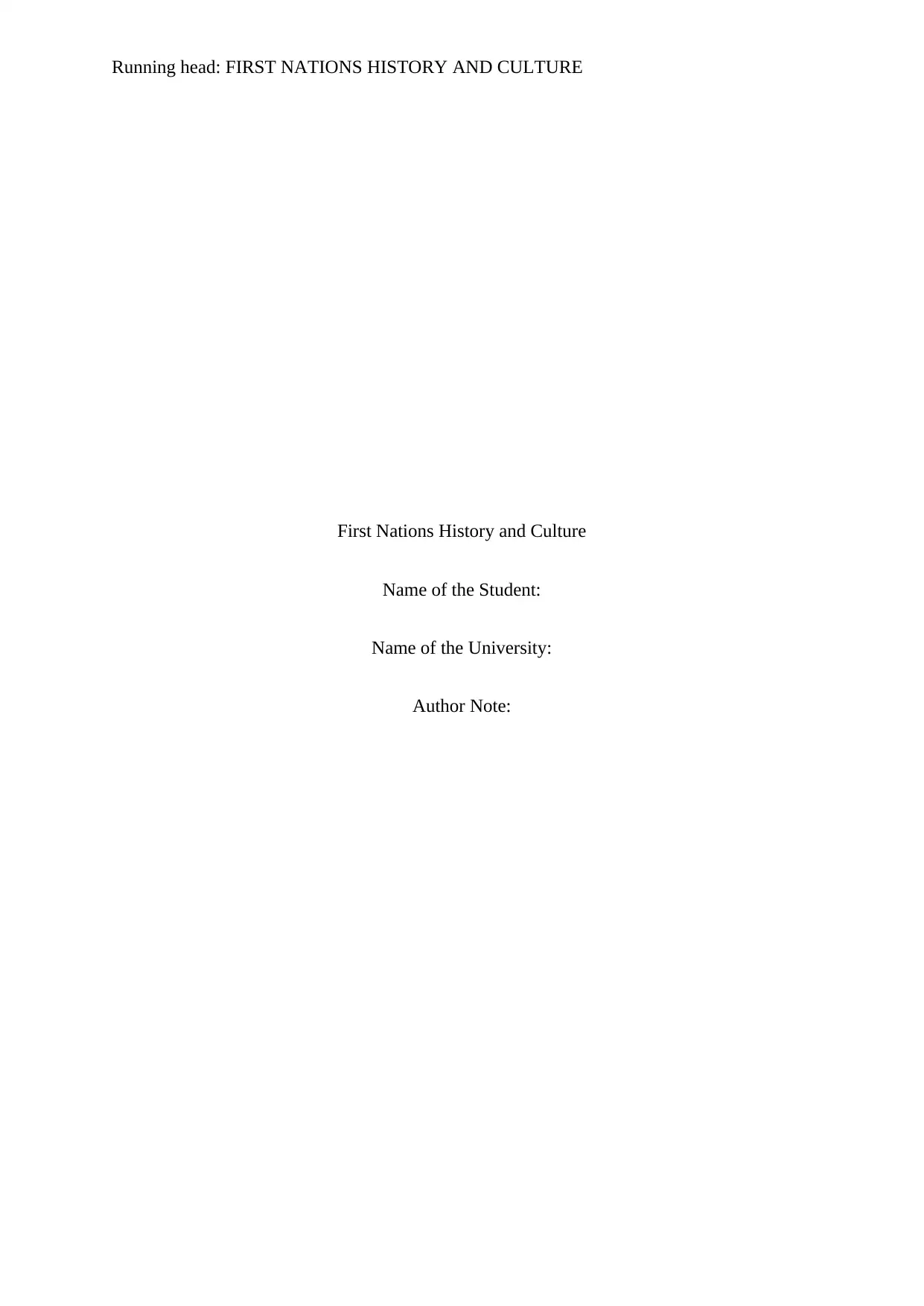
Running head: FIRST NATIONS HISTORY AND CULTURE
First Nations History and Culture
Name of the Student:
Name of the University:
Author Note:
First Nations History and Culture
Name of the Student:
Name of the University:
Author Note:
Secure Best Marks with AI Grader
Need help grading? Try our AI Grader for instant feedback on your assignments.
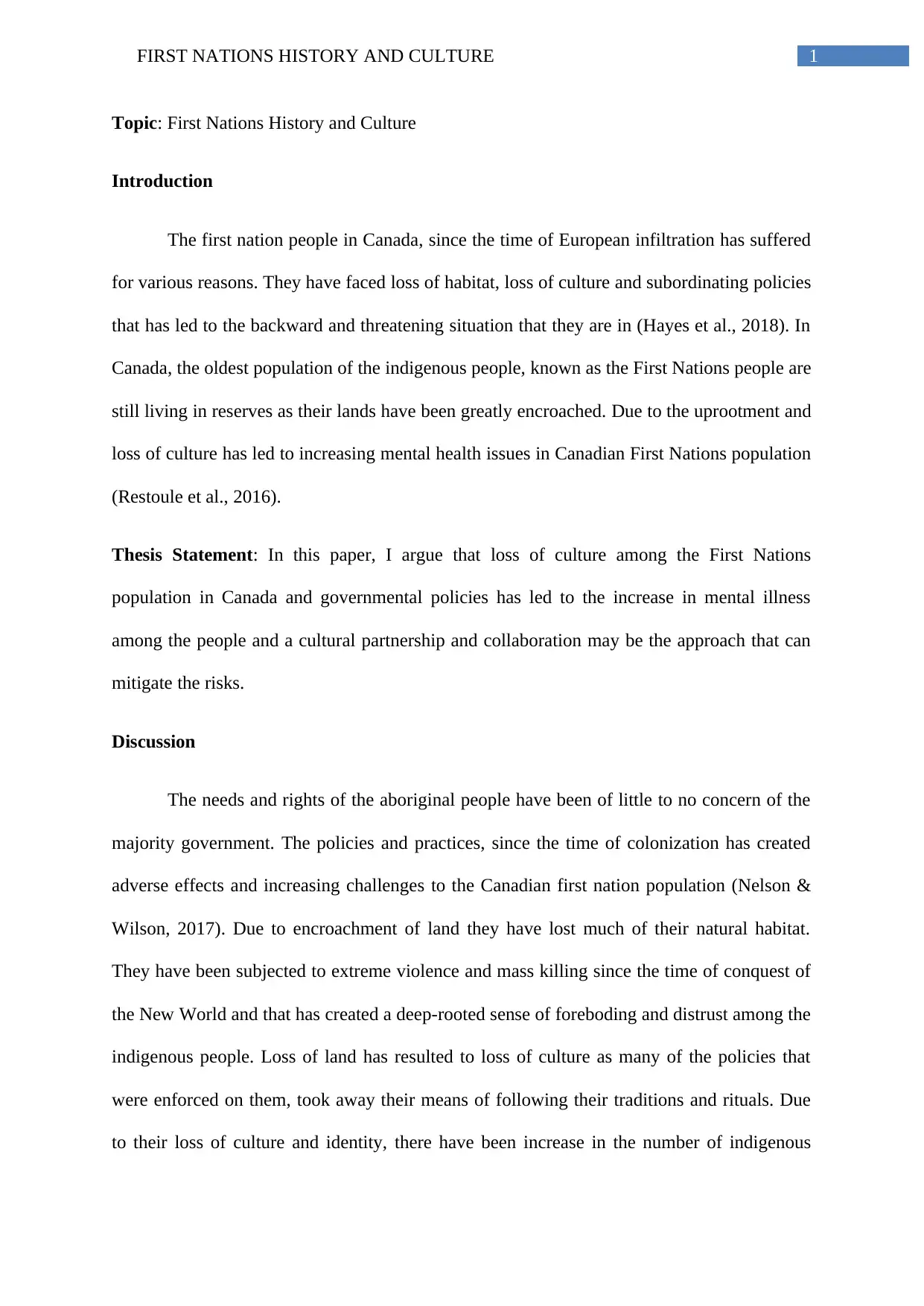
1FIRST NATIONS HISTORY AND CULTURE
Topic: First Nations History and Culture
Introduction
The first nation people in Canada, since the time of European infiltration has suffered
for various reasons. They have faced loss of habitat, loss of culture and subordinating policies
that has led to the backward and threatening situation that they are in (Hayes et al., 2018). In
Canada, the oldest population of the indigenous people, known as the First Nations people are
still living in reserves as their lands have been greatly encroached. Due to the uprootment and
loss of culture has led to increasing mental health issues in Canadian First Nations population
(Restoule et al., 2016).
Thesis Statement: In this paper, I argue that loss of culture among the First Nations
population in Canada and governmental policies has led to the increase in mental illness
among the people and a cultural partnership and collaboration may be the approach that can
mitigate the risks.
Discussion
The needs and rights of the aboriginal people have been of little to no concern of the
majority government. The policies and practices, since the time of colonization has created
adverse effects and increasing challenges to the Canadian first nation population (Nelson &
Wilson, 2017). Due to encroachment of land they have lost much of their natural habitat.
They have been subjected to extreme violence and mass killing since the time of conquest of
the New World and that has created a deep-rooted sense of foreboding and distrust among the
indigenous people. Loss of land has resulted to loss of culture as many of the policies that
were enforced on them, took away their means of following their traditions and rituals. Due
to their loss of culture and identity, there have been increase in the number of indigenous
Topic: First Nations History and Culture
Introduction
The first nation people in Canada, since the time of European infiltration has suffered
for various reasons. They have faced loss of habitat, loss of culture and subordinating policies
that has led to the backward and threatening situation that they are in (Hayes et al., 2018). In
Canada, the oldest population of the indigenous people, known as the First Nations people are
still living in reserves as their lands have been greatly encroached. Due to the uprootment and
loss of culture has led to increasing mental health issues in Canadian First Nations population
(Restoule et al., 2016).
Thesis Statement: In this paper, I argue that loss of culture among the First Nations
population in Canada and governmental policies has led to the increase in mental illness
among the people and a cultural partnership and collaboration may be the approach that can
mitigate the risks.
Discussion
The needs and rights of the aboriginal people have been of little to no concern of the
majority government. The policies and practices, since the time of colonization has created
adverse effects and increasing challenges to the Canadian first nation population (Nelson &
Wilson, 2017). Due to encroachment of land they have lost much of their natural habitat.
They have been subjected to extreme violence and mass killing since the time of conquest of
the New World and that has created a deep-rooted sense of foreboding and distrust among the
indigenous people. Loss of land has resulted to loss of culture as many of the policies that
were enforced on them, took away their means of following their traditions and rituals. Due
to their loss of culture and identity, there have been increase in the number of indigenous
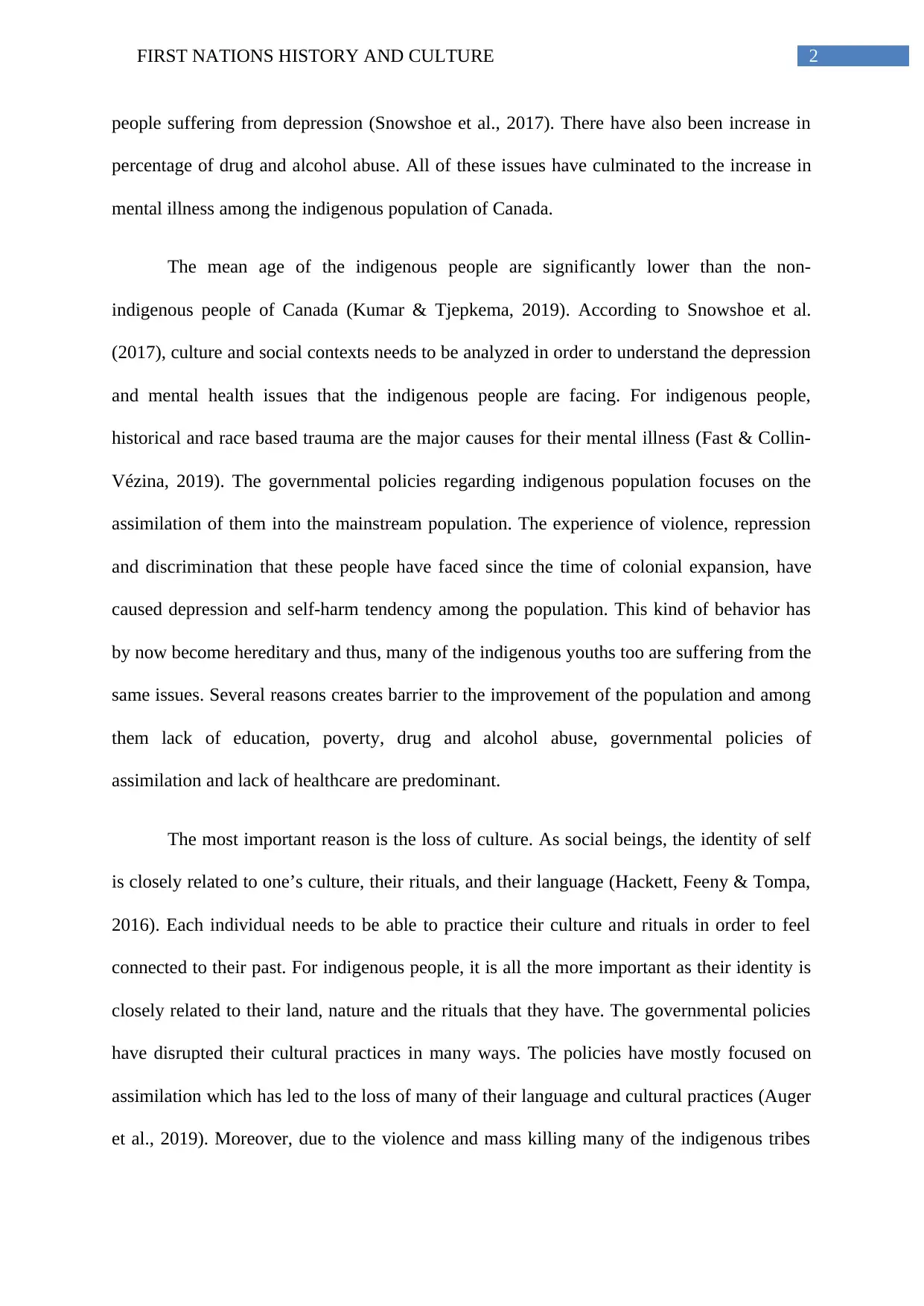
2FIRST NATIONS HISTORY AND CULTURE
people suffering from depression (Snowshoe et al., 2017). There have also been increase in
percentage of drug and alcohol abuse. All of these issues have culminated to the increase in
mental illness among the indigenous population of Canada.
The mean age of the indigenous people are significantly lower than the non-
indigenous people of Canada (Kumar & Tjepkema, 2019). According to Snowshoe et al.
(2017), culture and social contexts needs to be analyzed in order to understand the depression
and mental health issues that the indigenous people are facing. For indigenous people,
historical and race based trauma are the major causes for their mental illness (Fast & Collin-
Vézina, 2019). The governmental policies regarding indigenous population focuses on the
assimilation of them into the mainstream population. The experience of violence, repression
and discrimination that these people have faced since the time of colonial expansion, have
caused depression and self-harm tendency among the population. This kind of behavior has
by now become hereditary and thus, many of the indigenous youths too are suffering from the
same issues. Several reasons creates barrier to the improvement of the population and among
them lack of education, poverty, drug and alcohol abuse, governmental policies of
assimilation and lack of healthcare are predominant.
The most important reason is the loss of culture. As social beings, the identity of self
is closely related to one’s culture, their rituals, and their language (Hackett, Feeny & Tompa,
2016). Each individual needs to be able to practice their culture and rituals in order to feel
connected to their past. For indigenous people, it is all the more important as their identity is
closely related to their land, nature and the rituals that they have. The governmental policies
have disrupted their cultural practices in many ways. The policies have mostly focused on
assimilation which has led to the loss of many of their language and cultural practices (Auger
et al., 2019). Moreover, due to the violence and mass killing many of the indigenous tribes
people suffering from depression (Snowshoe et al., 2017). There have also been increase in
percentage of drug and alcohol abuse. All of these issues have culminated to the increase in
mental illness among the indigenous population of Canada.
The mean age of the indigenous people are significantly lower than the non-
indigenous people of Canada (Kumar & Tjepkema, 2019). According to Snowshoe et al.
(2017), culture and social contexts needs to be analyzed in order to understand the depression
and mental health issues that the indigenous people are facing. For indigenous people,
historical and race based trauma are the major causes for their mental illness (Fast & Collin-
Vézina, 2019). The governmental policies regarding indigenous population focuses on the
assimilation of them into the mainstream population. The experience of violence, repression
and discrimination that these people have faced since the time of colonial expansion, have
caused depression and self-harm tendency among the population. This kind of behavior has
by now become hereditary and thus, many of the indigenous youths too are suffering from the
same issues. Several reasons creates barrier to the improvement of the population and among
them lack of education, poverty, drug and alcohol abuse, governmental policies of
assimilation and lack of healthcare are predominant.
The most important reason is the loss of culture. As social beings, the identity of self
is closely related to one’s culture, their rituals, and their language (Hackett, Feeny & Tompa,
2016). Each individual needs to be able to practice their culture and rituals in order to feel
connected to their past. For indigenous people, it is all the more important as their identity is
closely related to their land, nature and the rituals that they have. The governmental policies
have disrupted their cultural practices in many ways. The policies have mostly focused on
assimilation which has led to the loss of many of their language and cultural practices (Auger
et al., 2019). Moreover, due to the violence and mass killing many of the indigenous tribes
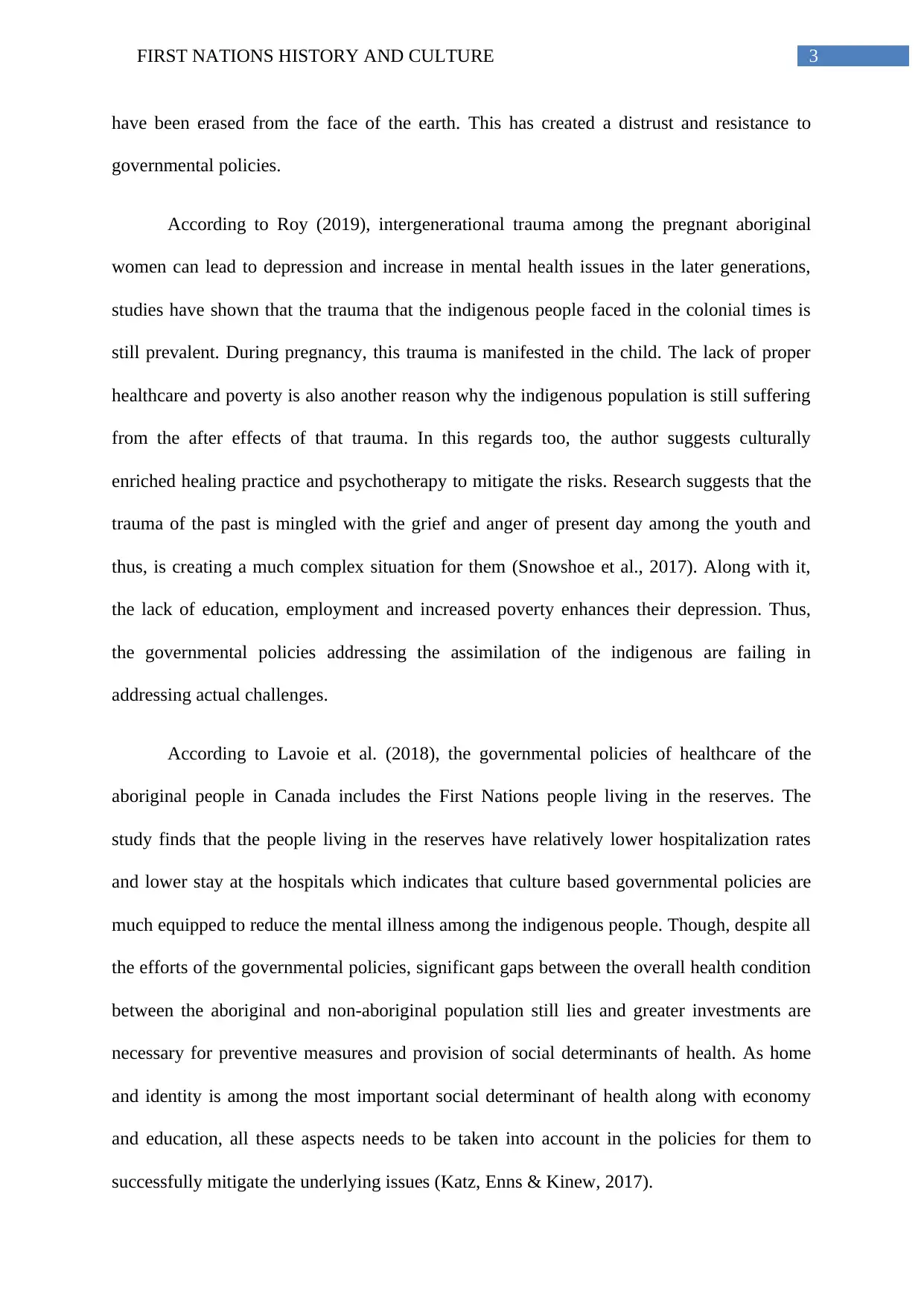
3FIRST NATIONS HISTORY AND CULTURE
have been erased from the face of the earth. This has created a distrust and resistance to
governmental policies.
According to Roy (2019), intergenerational trauma among the pregnant aboriginal
women can lead to depression and increase in mental health issues in the later generations,
studies have shown that the trauma that the indigenous people faced in the colonial times is
still prevalent. During pregnancy, this trauma is manifested in the child. The lack of proper
healthcare and poverty is also another reason why the indigenous population is still suffering
from the after effects of that trauma. In this regards too, the author suggests culturally
enriched healing practice and psychotherapy to mitigate the risks. Research suggests that the
trauma of the past is mingled with the grief and anger of present day among the youth and
thus, is creating a much complex situation for them (Snowshoe et al., 2017). Along with it,
the lack of education, employment and increased poverty enhances their depression. Thus,
the governmental policies addressing the assimilation of the indigenous are failing in
addressing actual challenges.
According to Lavoie et al. (2018), the governmental policies of healthcare of the
aboriginal people in Canada includes the First Nations people living in the reserves. The
study finds that the people living in the reserves have relatively lower hospitalization rates
and lower stay at the hospitals which indicates that culture based governmental policies are
much equipped to reduce the mental illness among the indigenous people. Though, despite all
the efforts of the governmental policies, significant gaps between the overall health condition
between the aboriginal and non-aboriginal population still lies and greater investments are
necessary for preventive measures and provision of social determinants of health. As home
and identity is among the most important social determinant of health along with economy
and education, all these aspects needs to be taken into account in the policies for them to
successfully mitigate the underlying issues (Katz, Enns & Kinew, 2017).
have been erased from the face of the earth. This has created a distrust and resistance to
governmental policies.
According to Roy (2019), intergenerational trauma among the pregnant aboriginal
women can lead to depression and increase in mental health issues in the later generations,
studies have shown that the trauma that the indigenous people faced in the colonial times is
still prevalent. During pregnancy, this trauma is manifested in the child. The lack of proper
healthcare and poverty is also another reason why the indigenous population is still suffering
from the after effects of that trauma. In this regards too, the author suggests culturally
enriched healing practice and psychotherapy to mitigate the risks. Research suggests that the
trauma of the past is mingled with the grief and anger of present day among the youth and
thus, is creating a much complex situation for them (Snowshoe et al., 2017). Along with it,
the lack of education, employment and increased poverty enhances their depression. Thus,
the governmental policies addressing the assimilation of the indigenous are failing in
addressing actual challenges.
According to Lavoie et al. (2018), the governmental policies of healthcare of the
aboriginal people in Canada includes the First Nations people living in the reserves. The
study finds that the people living in the reserves have relatively lower hospitalization rates
and lower stay at the hospitals which indicates that culture based governmental policies are
much equipped to reduce the mental illness among the indigenous people. Though, despite all
the efforts of the governmental policies, significant gaps between the overall health condition
between the aboriginal and non-aboriginal population still lies and greater investments are
necessary for preventive measures and provision of social determinants of health. As home
and identity is among the most important social determinant of health along with economy
and education, all these aspects needs to be taken into account in the policies for them to
successfully mitigate the underlying issues (Katz, Enns & Kinew, 2017).
Secure Best Marks with AI Grader
Need help grading? Try our AI Grader for instant feedback on your assignments.
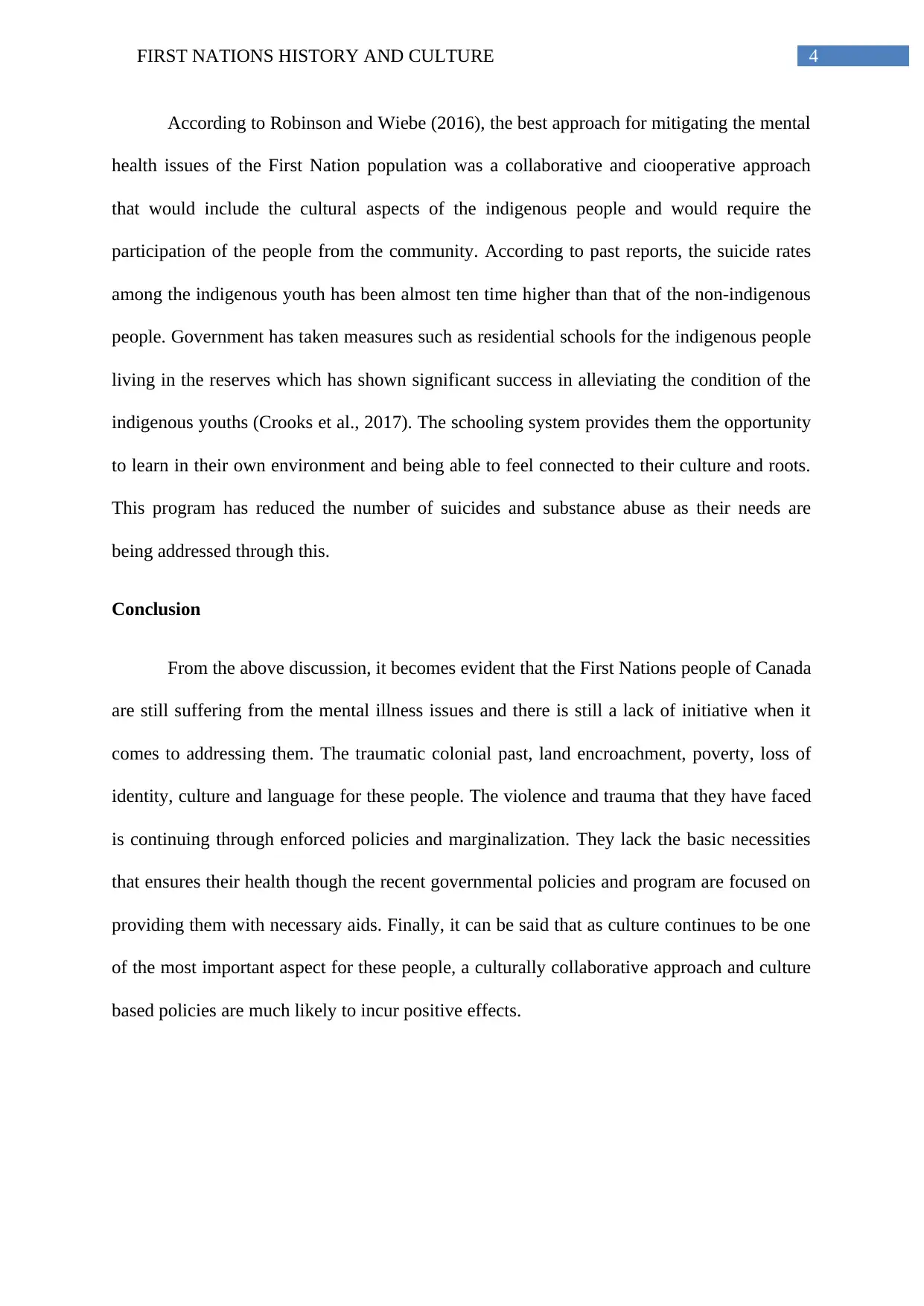
4FIRST NATIONS HISTORY AND CULTURE
According to Robinson and Wiebe (2016), the best approach for mitigating the mental
health issues of the First Nation population was a collaborative and ciooperative approach
that would include the cultural aspects of the indigenous people and would require the
participation of the people from the community. According to past reports, the suicide rates
among the indigenous youth has been almost ten time higher than that of the non-indigenous
people. Government has taken measures such as residential schools for the indigenous people
living in the reserves which has shown significant success in alleviating the condition of the
indigenous youths (Crooks et al., 2017). The schooling system provides them the opportunity
to learn in their own environment and being able to feel connected to their culture and roots.
This program has reduced the number of suicides and substance abuse as their needs are
being addressed through this.
Conclusion
From the above discussion, it becomes evident that the First Nations people of Canada
are still suffering from the mental illness issues and there is still a lack of initiative when it
comes to addressing them. The traumatic colonial past, land encroachment, poverty, loss of
identity, culture and language for these people. The violence and trauma that they have faced
is continuing through enforced policies and marginalization. They lack the basic necessities
that ensures their health though the recent governmental policies and program are focused on
providing them with necessary aids. Finally, it can be said that as culture continues to be one
of the most important aspect for these people, a culturally collaborative approach and culture
based policies are much likely to incur positive effects.
According to Robinson and Wiebe (2016), the best approach for mitigating the mental
health issues of the First Nation population was a collaborative and ciooperative approach
that would include the cultural aspects of the indigenous people and would require the
participation of the people from the community. According to past reports, the suicide rates
among the indigenous youth has been almost ten time higher than that of the non-indigenous
people. Government has taken measures such as residential schools for the indigenous people
living in the reserves which has shown significant success in alleviating the condition of the
indigenous youths (Crooks et al., 2017). The schooling system provides them the opportunity
to learn in their own environment and being able to feel connected to their culture and roots.
This program has reduced the number of suicides and substance abuse as their needs are
being addressed through this.
Conclusion
From the above discussion, it becomes evident that the First Nations people of Canada
are still suffering from the mental illness issues and there is still a lack of initiative when it
comes to addressing them. The traumatic colonial past, land encroachment, poverty, loss of
identity, culture and language for these people. The violence and trauma that they have faced
is continuing through enforced policies and marginalization. They lack the basic necessities
that ensures their health though the recent governmental policies and program are focused on
providing them with necessary aids. Finally, it can be said that as culture continues to be one
of the most important aspect for these people, a culturally collaborative approach and culture
based policies are much likely to incur positive effects.
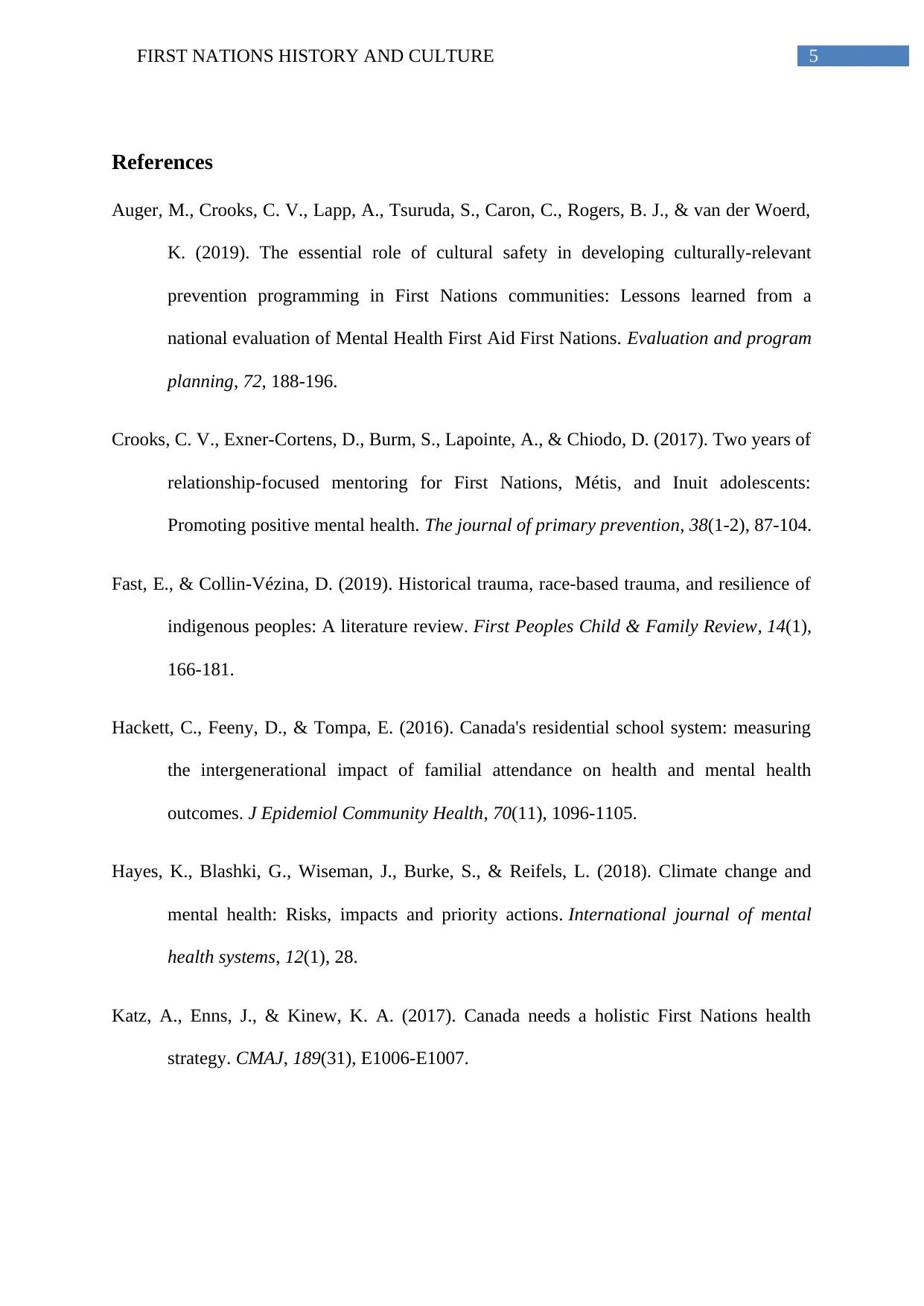
5FIRST NATIONS HISTORY AND CULTURE
References
Auger, M., Crooks, C. V., Lapp, A., Tsuruda, S., Caron, C., Rogers, B. J., & van der Woerd,
K. (2019). The essential role of cultural safety in developing culturally-relevant
prevention programming in First Nations communities: Lessons learned from a
national evaluation of Mental Health First Aid First Nations. Evaluation and program
planning, 72, 188-196.
Crooks, C. V., Exner-Cortens, D., Burm, S., Lapointe, A., & Chiodo, D. (2017). Two years of
relationship-focused mentoring for First Nations, Métis, and Inuit adolescents:
Promoting positive mental health. The journal of primary prevention, 38(1-2), 87-104.
Fast, E., & Collin-Vézina, D. (2019). Historical trauma, race-based trauma, and resilience of
indigenous peoples: A literature review. First Peoples Child & Family Review, 14(1),
166-181.
Hackett, C., Feeny, D., & Tompa, E. (2016). Canada's residential school system: measuring
the intergenerational impact of familial attendance on health and mental health
outcomes. J Epidemiol Community Health, 70(11), 1096-1105.
Hayes, K., Blashki, G., Wiseman, J., Burke, S., & Reifels, L. (2018). Climate change and
mental health: Risks, impacts and priority actions. International journal of mental
health systems, 12(1), 28.
Katz, A., Enns, J., & Kinew, K. A. (2017). Canada needs a holistic First Nations health
strategy. CMAJ, 189(31), E1006-E1007.
References
Auger, M., Crooks, C. V., Lapp, A., Tsuruda, S., Caron, C., Rogers, B. J., & van der Woerd,
K. (2019). The essential role of cultural safety in developing culturally-relevant
prevention programming in First Nations communities: Lessons learned from a
national evaluation of Mental Health First Aid First Nations. Evaluation and program
planning, 72, 188-196.
Crooks, C. V., Exner-Cortens, D., Burm, S., Lapointe, A., & Chiodo, D. (2017). Two years of
relationship-focused mentoring for First Nations, Métis, and Inuit adolescents:
Promoting positive mental health. The journal of primary prevention, 38(1-2), 87-104.
Fast, E., & Collin-Vézina, D. (2019). Historical trauma, race-based trauma, and resilience of
indigenous peoples: A literature review. First Peoples Child & Family Review, 14(1),
166-181.
Hackett, C., Feeny, D., & Tompa, E. (2016). Canada's residential school system: measuring
the intergenerational impact of familial attendance on health and mental health
outcomes. J Epidemiol Community Health, 70(11), 1096-1105.
Hayes, K., Blashki, G., Wiseman, J., Burke, S., & Reifels, L. (2018). Climate change and
mental health: Risks, impacts and priority actions. International journal of mental
health systems, 12(1), 28.
Katz, A., Enns, J., & Kinew, K. A. (2017). Canada needs a holistic First Nations health
strategy. CMAJ, 189(31), E1006-E1007.
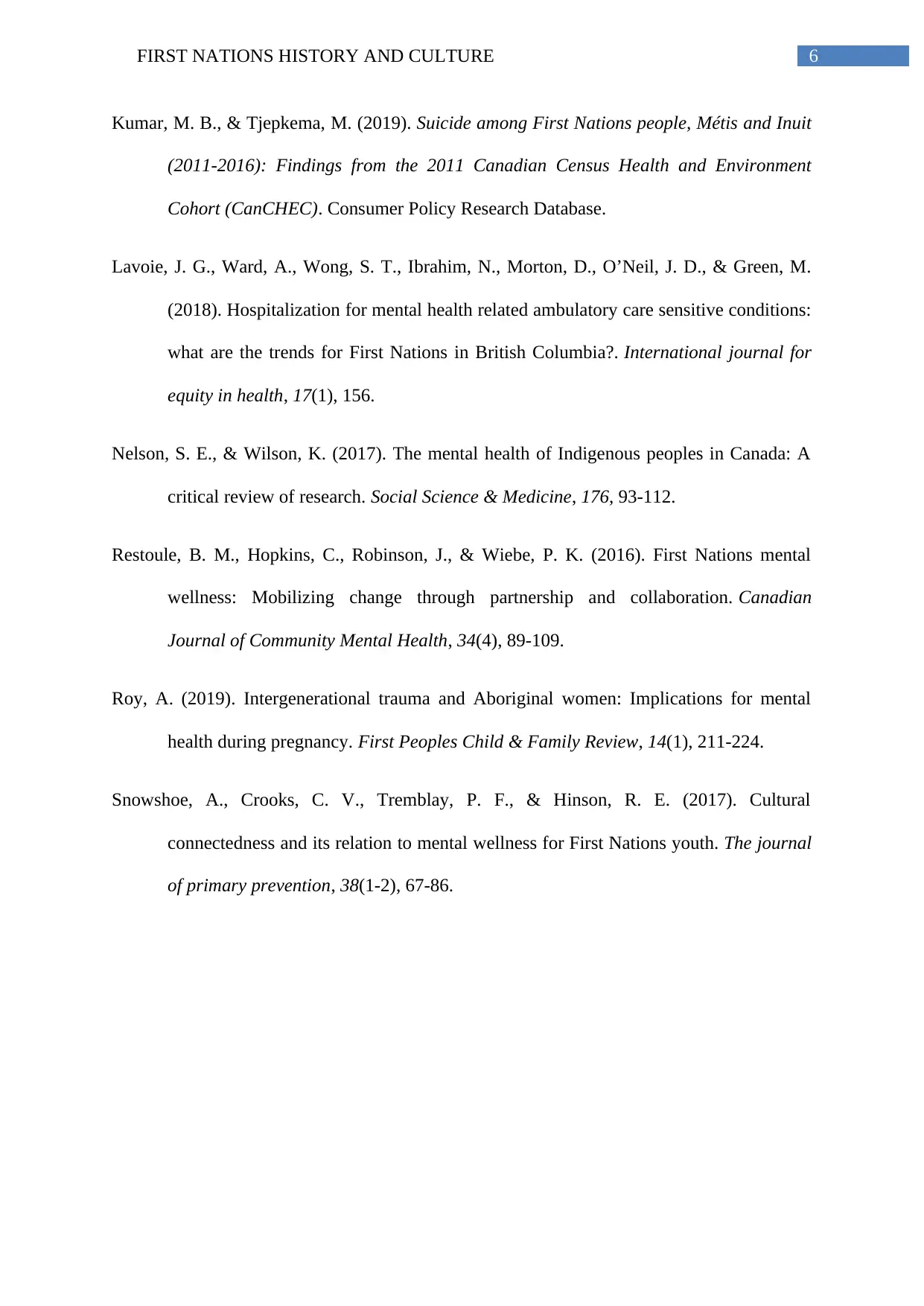
6FIRST NATIONS HISTORY AND CULTURE
Kumar, M. B., & Tjepkema, M. (2019). Suicide among First Nations people, Métis and Inuit
(2011-2016): Findings from the 2011 Canadian Census Health and Environment
Cohort (CanCHEC). Consumer Policy Research Database.
Lavoie, J. G., Ward, A., Wong, S. T., Ibrahim, N., Morton, D., O’Neil, J. D., & Green, M.
(2018). Hospitalization for mental health related ambulatory care sensitive conditions:
what are the trends for First Nations in British Columbia?. International journal for
equity in health, 17(1), 156.
Nelson, S. E., & Wilson, K. (2017). The mental health of Indigenous peoples in Canada: A
critical review of research. Social Science & Medicine, 176, 93-112.
Restoule, B. M., Hopkins, C., Robinson, J., & Wiebe, P. K. (2016). First Nations mental
wellness: Mobilizing change through partnership and collaboration. Canadian
Journal of Community Mental Health, 34(4), 89-109.
Roy, A. (2019). Intergenerational trauma and Aboriginal women: Implications for mental
health during pregnancy. First Peoples Child & Family Review, 14(1), 211-224.
Snowshoe, A., Crooks, C. V., Tremblay, P. F., & Hinson, R. E. (2017). Cultural
connectedness and its relation to mental wellness for First Nations youth. The journal
of primary prevention, 38(1-2), 67-86.
Kumar, M. B., & Tjepkema, M. (2019). Suicide among First Nations people, Métis and Inuit
(2011-2016): Findings from the 2011 Canadian Census Health and Environment
Cohort (CanCHEC). Consumer Policy Research Database.
Lavoie, J. G., Ward, A., Wong, S. T., Ibrahim, N., Morton, D., O’Neil, J. D., & Green, M.
(2018). Hospitalization for mental health related ambulatory care sensitive conditions:
what are the trends for First Nations in British Columbia?. International journal for
equity in health, 17(1), 156.
Nelson, S. E., & Wilson, K. (2017). The mental health of Indigenous peoples in Canada: A
critical review of research. Social Science & Medicine, 176, 93-112.
Restoule, B. M., Hopkins, C., Robinson, J., & Wiebe, P. K. (2016). First Nations mental
wellness: Mobilizing change through partnership and collaboration. Canadian
Journal of Community Mental Health, 34(4), 89-109.
Roy, A. (2019). Intergenerational trauma and Aboriginal women: Implications for mental
health during pregnancy. First Peoples Child & Family Review, 14(1), 211-224.
Snowshoe, A., Crooks, C. V., Tremblay, P. F., & Hinson, R. E. (2017). Cultural
connectedness and its relation to mental wellness for First Nations youth. The journal
of primary prevention, 38(1-2), 67-86.
1 out of 7
Related Documents
Your All-in-One AI-Powered Toolkit for Academic Success.
+13062052269
info@desklib.com
Available 24*7 on WhatsApp / Email
![[object Object]](/_next/static/media/star-bottom.7253800d.svg)
Unlock your academic potential
© 2024 | Zucol Services PVT LTD | All rights reserved.





